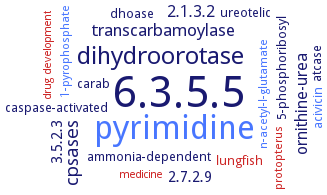6.3.5.5: carbamoyl-phosphate synthase (glutamine-hydrolysing)
This is an abbreviated version!
For detailed information about carbamoyl-phosphate synthase (glutamine-hydrolysing), go to the full flat file.

Word Map on EC 6.3.5.5 
-
6.3.5.5
-
pyrimidine
-
dihydroorotase
-
cpsases
-
transcarbamoylase
-
2.1.3.2
-
ornithine-urea
-
2.7.2.9
-
3.5.2.3
-
acivicin
-
caspase-activated
-
dhoase
-
ureotelic
-
atcase
-
lungfish
-
ammonia-dependent
-
carab
-
5-phosphoribosyl
-
1-pyrophosphate
-
protopterus
-
n-acetyl-l-glutamate
-
drug development
-
medicine
- 6.3.5.5
- pyrimidine
- dihydroorotase
- cpsases
-
transcarbamoylase
-
2.1.3.2
-
ornithine-urea
-
2.7.2.9
-
3.5.2.3
- acivicin
-
caspase-activated
- dhoase
-
ureotelic
- atcase
- lungfish
-
ammonia-dependent
-
carab
-
5-phosphoribosyl
- 1-pyrophosphate
- protopterus
- n-acetyl-l-glutamate
- drug development
- medicine
Reaction
2 ATP
+
Synonyms
CAD, CAD carbamoyl-phosphate synthetase, CAD protein, Carbamoyl phosphate synthase (glutamine), carbamoyl phosphate synthetase, Carbamoyl phosphate synthetase (glutamine-hydrolyzing), carbamoyl phosphate synthetase 1, carbamoyl phosphate synthetase II, carbamoyl phosphate synthetase III, carbamoyl-phosphate synthetase, Carbamoyl-phosphate synthetase (glutamine-hydrolysing), carbamoyl-phosphate synthetase 2, Carbamoylphosphate synthase, Carbamoylphosphate synthetase, Carbamoylphosphate synthetase II, Carbamyl phosphate synthetase (glutamine), Carbamyl phosphate sythetase II, carbamylphosphate synthetase - aspartate transcarbamylase, CPA2, CPS, CPS II (glutamine-dependent), CPS III, CPS III (glutamine- and N-acetyl-L-glutamine-dependent), CPS1, CPSase, CPSase type II, CPSase-A, CPSase-P, CPSII, EC 2.7.2.9, Glutamine-dependent carbamyl phosphate synthetase, glutamine-hydrolyzing CPSase, MGG_04503, More, MtCPSs1, MtCPSs2, Synthase, carbamoylphosphate (glutamine), Synthetase, carbamoylphosphate (glutamine-hydrolyzing)


 results (
results ( results (
results ( top
top





